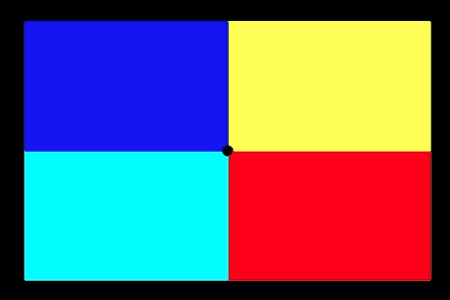Here's an optical illusion GIF that I created to demonstrate color afterimages. Bring your face close, turn up your screen brightness, and stare at the center of the grid.
(Direct link if the GIF doesn't work) Every three seconds it switches from bright colors to neutral gray. The afterimage effect tinges the gray squares with the complementary (or opposite) color. The effect doesn't last long because the stimulus is short and the color receptors don't have much time to get depleted.
(Video link) The same principle applies to this video, where a color afterimage infuses a black and white photo with the appearance of natural color.
To get the best effect, watch the video at full screen size and stare for the duration of video at the dot in the center. When it switches over to the photo, keep looking at the center. Your retinas have been primed with a seemingly random (but really a complementary) color pattern for a longer period of time. The colors are more stable this time because the depletion is more dramatic.
Thursday, March 7, 2013
Color Afterimages
Labels:
Color,
Visual Perception
Subscribe to:
Post Comments (Atom)








3 comments:
This may be a dumb question(s), but If it wasn't for the black and white photograph added to your brain's after image in the video, it would only appear to be large shapes of color... So your brain only balances out color but not tonality? What is the reason for this after image of color and what is the reason, if any for this absence of tonal balance? Or am I just missing something really obvious...
In fact, I'm sure it's in my Color and Light book, I'll open it up and see if you haven't already answered this...
This video is awesome by the way.
Daniel, it's a GREAT question, and I'll take a stab at it, but I'm hoping someone else can answer it better than I'm about to.
Basically, your perception of colored objects involves interactions of various visual clues. One set of clues is the response of the color receptors themselves, which work not only by exciting one channel (say "red"), but by opposing or inhibiting another ("opponent process theory.") This information is added to tonal information, which is largely processed in a different part of the brain.
One misconception is that tonal information only comes from the rod cells, but it also comes from the cones. There's also visual processing for depth and edges and faces and other features added to the mix. Your brain stitches together all sorts of clues together starting in the retina and going all the way to other areas of the brain. This happens mostly automatically to create a (hopefully) stable perception.
It's the job of people who create optical illusion to tease apart those separate streams of information and to put them into paradoxical conflict, so making an image appear impossible.
Thanks for posting this!! It was so effective that I had to glance to another part of the photo after the switch, because I wasn't sure if they had put in the real photo! It's startling.
Post a Comment